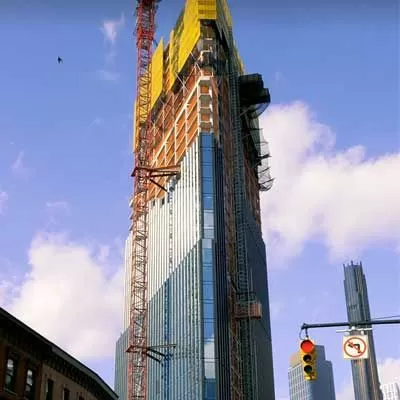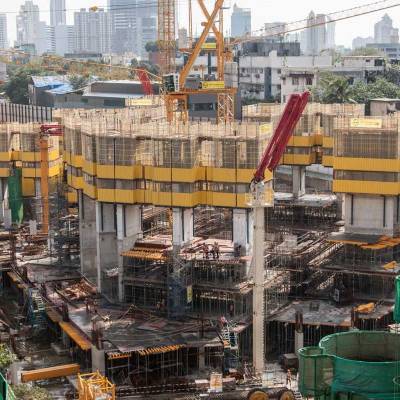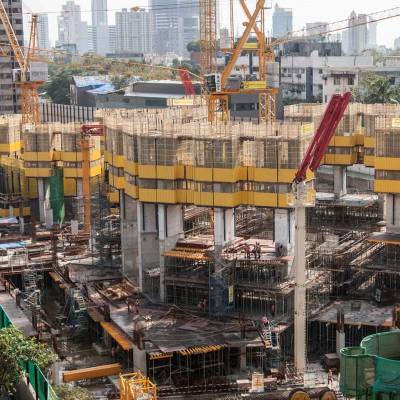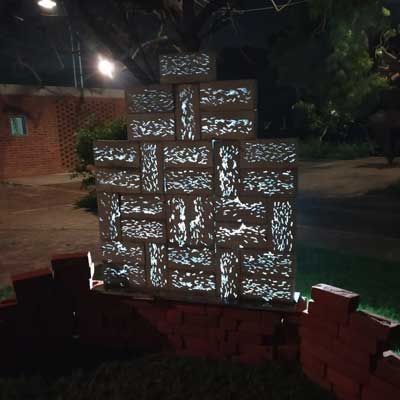- Home
- Real Estate
- Form´at to build

Form´at to build
Is it wise to invest in system formwork? With system formwork enjoying a market share of just 10-15 per cent of the industry, according to Surajit Ray, Managing Director, Ulma Formwork Systems India, many contractors are still stuck on that question despite the known positives.
Cutting cycle time
In any high-rise construction, the formwork cycle time is one of the key factors influencing project duration, says G Boopathi, Manager Civil, Technology Competency Centre, Heavy Civil Infrastructure IC, Larsen & Toubro.
A faster formwork cycle saves project time and cost to a great extent by enabling early completion and because it can be reused many times.
¨System formwork cuts cycle time by 40-50 per cent,¨ affirms Akhil Kumar Sureka, Managing Director, Sarvome Developers. In days, the slab cycle with MFE formwork would be about six against the traditional slab cycle of 21, according to Ketan Shah, Managing Director, MFE Formwork Technology (I). ¨System formwork facilitates an eight to nine day cycle against a conventional 12 to 14 day cycle,¨ says Shreeniwas Kelkar, Country Product & Marketing Manager, Doka India.
So how does system formwork save time vis-á-vis conventional formwork?
Essentially, it is up to 40 per cent lighter, easier to place, and has fewer components to assemble and de-shutter. ¨We reckon conventional formwork has 38 per cent more ties and four times more props than Doka formwork,¨ says Kelkar. ¨System formwork also saves interest and labour costs while helping to build a brand by ensuring on-time delivery and a better finish than conventional formwork. Doka formwork delivers up to 57 per cent savings over conventional formwork.¨
Different gains
Different kinds of formwork vary in their capacity to impact the speed of execution. ¨As against 14 days for completing the RCC work of one floor of a building with conventional formwork, aluminium formwork like Myvan can cut the time cycle to seven to eight days per floor if other supporting facilities, like the crane for handling and concreting equipment, are on hand,¨ opines Samar Ghoshdastidar, Technical Director, Simplex Infrastructures. ¨Tunnel formwork with its heat control curing system technology can speed up the cycle to even one day.¨
¨Automatic climbing formworks and lightweight manually handled formwork are both faster than crane climbing formwork systems,¨ says Ray.
However, not just any formwork has the potential to save time. ¨Only the most appropriate system formwork for a project, when provided for in optimum quantity for the project completion schedule, can help cut up to 30 per cent of project time compared to conventional formwork systems,¨ adds Ray. ¨Other factors impacting the choice of formwork solution and support system are detailed structural analysis, the weight of concrete, pressure exerted by concrete while concreting and the resistance offered by the formwork system.¨
Avoiding formwork failure
In construction, 60 per cent of RCC work failures are caused by formwork collapse, shoring collapse, inadequate shoring and lateral bracing, 8 per cent are owing to premature removal of shore and 18 per cent are because of faulty materials, explains Neeraj Kumar Jha, Associate Professor, Department of Civil Engineering, Indian Institute of Technology-Delhi.
To eliminate fatalities, injuries and business loss from accidents at construction sites, contractors must give formwork its due. Considering it a temporary prop in the construction process can lead to failure.
¨To avoid failures, first and foremost, all the formwork should be properly designed by a competent structural engineer and made as per specification with proper material. Thereafter, it should be erected and maintained under expert supervision during the complete execution of work,¨ affirms Ghoshdastidar. ¨Faulty design and fabrication and poor execution are major reasons for formwork collapse. Mishandling is another reason,¨ agrees Shah. ¨Faulty design, poor quality of formwork and overloading are important reasons for formwork collapse, which the contractor must take care of,¨ echoes Sureka.
Ideally, the design should comply with international standards on strength and deflection parameters. Then, it must be made in a modern facility following stringent quality control procedures.
For instance, to help achieve the desired result without mishaps, MFE deputes a supervisor to the contractor´s site for about eight weeks of training in using formwork, and issues a formwork manual.
Towards greater acceptance
Boopathi is positive about the way the industry is heading. ¨More widespread use of system formwork, greater acceptance of formwork usage methods, improved worker skill levels as a result of proper training, better awareness of safety measures and pre and post concreting inspections are preventing formwork accidents and failures to a large extent,¨ he says.
Indeed, ¨Gradually, system formwork is becoming the preferred choice among contractors at all levels,¨ says Ray. ¨High-rise buildings in metros, strict execution schedules to complete infrastructure projects (with heavy penalties for time overruns), safety consciousness and increasing strictures imposed upon contractors are creating demand for Ulma formwork.¨
- Developers for quality, safety, time and cost saving capabilities in any formwork system.
- System formwork cuts cycle time by 40-50 per cent - contractors´ preferred choice.
- Automatic climbing and lightweight manually handled formworks are faster than crane climbing systems.
Build ´x´ floors to recover investment in formwork
How many times do you need to reuse formwork to recover your investment in it? Here´s a back-of-the-envelope calculation from Shreeniwas Kelkar, Country Product & Marketing Manager, Doka India: ¨It takes four similar types of projects to recover the upfront cost of formwork. For instance, a developer investing in formwork of 1,000 sq m for a G+10 structure with 1,000 sq m as floor area would recover the investment after reusing the formwork for three more similar projects. Recovering the cost of formwork is a function of repetition.¨
Formwork vs RCC cost
The cost of formwork as a fraction of the RCC cost varies greatly. Among key influencing factors are the type of structure (commercial, residential, circular tank, nuclear power project, etc), cycle period between successive concrete pours (this determines the quantity of the formwork needed), type of formwork system (crane or manually handled), the investment mode (purchase, buyback or rental) and the type of construction (cast-in-situ or pre-cast segmental), according to Surajit Ray, Managing Director, Ulma Formwork Systems India.
CW polled all respondents on this proportion. Here´s what they say. ¨In general, the cost of the formwork may vary between 3 per cent and 7 per cent of the RCC project cost,¨ adds Ray.
¨System formwork costs 5-6 per cent of total construction cost including safety, depending on the project size, shape, complexity matrix and the number of times the formwork is used,¨ says Shreeniwas Kelkar, Country Product & Marketing Manager, Doka India.
¨Generally, about 8 per cent of total RCC cost is required for formwork,¨ says Samar Ghoshdastidar, Technical Director, Simplex Infrastructures.
¨Formwork makes up about 13 per cent of the total RCC project cost of a 20-storey column-beam-slab type of construction,¨ says Ketan Shah, Managing Director, MFE Formwork Technology (I), with the height of the building and type of structure (all concrete walls or column beam slab with masonry partitions) influencing this proportion.
¨We reckon system formwork makes up about 15-20 per cent of the cost of structural works if considerable repetitions are achieved,¨ opines G Boopathi, Manager Civil, Technology Competency Centre, Heavy Civil Infrastructure IC, Larsen & Toubro.
¨System formwork makes up roughly 25 per cent of the project cost,¨ says Akhil Kumar Sureka, Managing Director, Sarvome Developers.
¨Formwork costs about a third of the overall RCC cost; time-wise it could even take up to 75 per cenr of the total time,¨ said Neeraj Kumar Jha, Associate Professor, Department of Civil Engineering, Indian Institute of Technology-Delhi.
What do contractors look for in formwork?
Contractors look for system formwork made of lightweight materials for easy handling, with fewer loose or small components like locking pins, wedges, etc, says G Boopathi, Manager Civil, Technology Competency Centre, Heavy Civil Infrastructure IC, Larsen & Toubro. ¨We also prefer error-proof systems that can be reused many times and are flexible enough to use for different applications.¨
¨We look for formwork of accurate size and shape as the structural drawing mandates. It should be amendable to be easily and speedily modified to a different size and shape as per the project requirement with minimum wastage,¨ says Samar Ghoshdastidar, Technical Director, Simplex Infrastructures. ¨Formwork joints should be leak-proof to avoid any leakage of cement slurry during compaction of concrete by vibration. Good formwork should retain its original shape, size and other qualities even after many reuses. It should be strong enough to support the concrete and have a smooth inner surface for a good finish.¨
¨We look for quality, safety features, time-saving capability and cost in any formwork system,¨ says Akhil Kumar Sureka, Managing Director, Sarvome Developers.
To share your views on the Scaffolding & Formwork market in India, write in at feedback@ConstructionWorld.in
- Formwork
- RCC Works
- Surajit Ray
- Ulma Formwork Systems India
- G Boopathi
- Heavy Civil Infrastructure IC
- Larsen & Toubro
- Akhil Kumar Sureka
- Sarvome Developers
- MFE Formwork
- Ketan Shah
- MFE Formwork Technology (I)
- Shreeniwas Kelkar
- Doka India
- Myvan
- Samar Ghoshdastidar
- Simplex Infrastructures
- Neeraj Kumar Jha
- Indian Institute of Technology
- Delhi
What impact does system formwork have on project duration? What does it cost as a proportion of RCC works? How can formwork failure be avoided? Is it wise to invest in system formwork? With system formwork enjoying a market share of just 10-15 per cent of the industry, according to Surajit Ray, Managing Director, Ulma Formwork Systems India, many contractors are still stuck on that question despite the known positives. Cutting cycle time In any high-rise construction, the formwork cycle time is one of the key factors influencing project duration, says G Boopathi, Manager Civil, Technology Competency Centre, Heavy Civil Infrastructure IC, Larsen & Toubro. A faster formwork cycle saves project time and cost to a great extent by enabling early completion and because it can be reused many times. ¨System formwork cuts cycle time by 40-50 per cent,¨ affirms Akhil Kumar Sureka, Managing Director, Sarvome Developers. In days, the slab cycle with MFE formwork would be about six against the traditional slab cycle of 21, according to Ketan Shah, Managing Director, MFE Formwork Technology (I). ¨System formwork facilitates an eight to nine day cycle against a conventional 12 to 14 day cycle,¨ says Shreeniwas Kelkar, Country Product & Marketing Manager, Doka India. So how does system formwork save time vis-á-vis conventional formwork? Essentially, it is up to 40 per cent lighter, easier to place, and has fewer components to assemble and de-shutter. ¨We reckon conventional formwork has 38 per cent more ties and four times more props than Doka formwork,¨ says Kelkar. ¨System formwork also saves interest and labour costs while helping to build a brand by ensuring on-time delivery and a better finish than conventional formwork. Doka formwork delivers up to 57 per cent savings over conventional formwork.¨ Different gains Different kinds of formwork vary in their capacity to impact the speed of execution. ¨As against 14 days for completing the RCC work of one floor of a building with conventional formwork, aluminium formwork like Myvan can cut the time cycle to seven to eight days per floor if other supporting facilities, like the crane for handling and concreting equipment, are on hand,¨ opines Samar Ghoshdastidar, Technical Director, Simplex Infrastructures. ¨Tunnel formwork with its heat control curing system technology can speed up the cycle to even one day.¨ ¨Automatic climbing formworks and lightweight manually handled formwork are both faster than crane climbing formwork systems,¨ says Ray. However, not just any formwork has the potential to save time. ¨Only the most appropriate system formwork for a project, when provided for in optimum quantity for the project completion schedule, can help cut up to 30 per cent of project time compared to conventional formwork systems,¨ adds Ray. ¨Other factors impacting the choice of formwork solution and support system are detailed structural analysis, the weight of concrete, pressure exerted by concrete while concreting and the resistance offered by the formwork system.¨ Avoiding formwork failure In construction, 60 per cent of RCC work failures are caused by formwork collapse, shoring collapse, inadequate shoring and lateral bracing, 8 per cent are owing to premature removal of shore and 18 per cent are because of faulty materials, explains Neeraj Kumar Jha, Associate Professor, Department of Civil Engineering, Indian Institute of Technology-Delhi. To eliminate fatalities, injuries and business loss from accidents at construction sites, contractors must give formwork its due. Considering it a temporary prop in the construction process can lead to failure. ¨To avoid failures, first and foremost, all the formwork should be properly designed by a competent structural engineer and made as per specification with proper material. Thereafter, it should be erected and maintained under expert supervision during the complete execution of work,¨ affirms Ghoshdastidar. ¨Faulty design and fabrication and poor execution are major reasons for formwork collapse. Mishandling is another reason,¨ agrees Shah. ¨Faulty design, poor quality of formwork and overloading are important reasons for formwork collapse, which the contractor must take care of,¨ echoes Sureka. Ideally, the design should comply with international standards on strength and deflection parameters. Then, it must be made in a modern facility following stringent quality control procedures. For instance, to help achieve the desired result without mishaps, MFE deputes a supervisor to the contractor´s site for about eight weeks of training in using formwork, and issues a formwork manual. Towards greater acceptance Boopathi is positive about the way the industry is heading. ¨More widespread use of system formwork, greater acceptance of formwork usage methods, improved worker skill levels as a result of proper training, better awareness of safety measures and pre and post concreting inspections are preventing formwork accidents and failures to a large extent,¨ he says. Indeed, ¨Gradually, system formwork is becoming the preferred choice among contractors at all levels,¨ says Ray. ¨High-rise buildings in metros, strict execution schedules to complete infrastructure projects (with heavy penalties for time overruns), safety consciousness and increasing strictures imposed upon contractors are creating demand for Ulma formwork.¨ Developers for quality, safety, time and cost saving capabilities in any formwork system. System formwork cuts cycle time by 40-50 per cent - contractors´ preferred choice. Automatic climbing and lightweight manually handled formworks are faster than crane climbing systems. Build ´x´ floors to recover investment in formwork How many times do you need to reuse formwork to recover your investment in it? Here´s a back-of-the-envelope calculation from Shreeniwas Kelkar, Country Product & Marketing Manager, Doka India: ¨It takes four similar types of projects to recover the upfront cost of formwork. For instance, a developer investing in formwork of 1,000 sq m for a G+10 structure with 1,000 sq m as floor area would recover the investment after reusing the formwork for three more similar projects. Recovering the cost of formwork is a function of repetition.¨ Formwork vs RCC cost The cost of formwork as a fraction of the RCC cost varies greatly. Among key influencing factors are the type of structure (commercial, residential, circular tank, nuclear power project, etc), cycle period between successive concrete pours (this determines the quantity of the formwork needed), type of formwork system (crane or manually handled), the investment mode (purchase, buyback or rental) and the type of construction (cast-in-situ or pre-cast segmental), according to Surajit Ray, Managing Director, Ulma Formwork Systems India. CW polled all respondents on this proportion. Here´s what they say. ¨In general, the cost of the formwork may vary between 3 per cent and 7 per cent of the RCC project cost,¨ adds Ray. ¨System formwork costs 5-6 per cent of total construction cost including safety, depending on the project size, shape, complexity matrix and the number of times the formwork is used,¨ says Shreeniwas Kelkar, Country Product & Marketing Manager, Doka India. ¨Generally, about 8 per cent of total RCC cost is required for formwork,¨ says Samar Ghoshdastidar, Technical Director, Simplex Infrastructures. ¨Formwork makes up about 13 per cent of the total RCC project cost of a 20-storey column-beam-slab type of construction,¨ says Ketan Shah, Managing Director, MFE Formwork Technology (I), with the height of the building and type of structure (all concrete walls or column beam slab with masonry partitions) influencing this proportion. ¨We reckon system formwork makes up about 15-20 per cent of the cost of structural works if considerable repetitions are achieved,¨ opines G Boopathi, Manager Civil, Technology Competency Centre, Heavy Civil Infrastructure IC, Larsen & Toubro. ¨System formwork makes up roughly 25 per cent of the project cost,¨ says Akhil Kumar Sureka, Managing Director, Sarvome Developers. ¨Formwork costs about a third of the overall RCC cost; time-wise it could even take up to 75 per cenr of the total time,¨ said Neeraj Kumar Jha, Associate Professor, Department of Civil Engineering, Indian Institute of Technology-Delhi. What do contractors look for in formwork? Contractors look for system formwork made of lightweight materials for easy handling, with fewer loose or small components like locking pins, wedges, etc, says G Boopathi, Manager Civil, Technology Competency Centre, Heavy Civil Infrastructure IC, Larsen & Toubro. ¨We also prefer error-proof systems that can be reused many times and are flexible enough to use for different applications.¨ ¨We look for formwork of accurate size and shape as the structural drawing mandates. It should be amendable to be easily and speedily modified to a different size and shape as per the project requirement with minimum wastage,¨ says Samar Ghoshdastidar, Technical Director, Simplex Infrastructures. ¨Formwork joints should be leak-proof to avoid any leakage of cement slurry during compaction of concrete by vibration. Good formwork should retain its original shape, size and other qualities even after many reuses. It should be strong enough to support the concrete and have a smooth inner surface for a good finish.¨ ¨We look for quality, safety features, time-saving capability and cost in any formwork system,¨ says Akhil Kumar Sureka, Managing Director, Sarvome Developers. To share your views on the Scaffolding & Formwork market in India, write in at feedback@ConstructionWorld.in
























